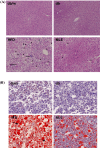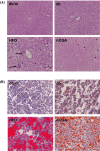Improving the Effects of Mulberry Leaves and Neochlorogenic Acid on Glucotoxicity-Induced Hepatic Steatosis in High Fat Diet Treated db/db Mice
- PMID: 38488910
- PMCID: PMC10979445
- DOI: 10.1021/acs.jafc.3c09033
Improving the Effects of Mulberry Leaves and Neochlorogenic Acid on Glucotoxicity-Induced Hepatic Steatosis in High Fat Diet Treated db/db Mice
Abstract
There are many complications of type 2 diabetes mellitus. Nonalcoholic fatty liver disease (NAFLD) and nonalcoholic steatohepatitis (NASH) are two complications related to the increased lipid accumulation in the liver. Previous studies have shown that mulberry leaf water extract (MLE) has the effect of lowering lipid levels in peripheral blood, inhibiting the expression of fatty acid synthase (FASN) and increasing the activity of liver antioxidant enzymes superoxide dismutase (SOD) and catalase. Our study aimed to investigate the role of MLE and its main component, neochlorogenic acid (nCGA), in reducing serum lipid profiles, decreasing lipid deposition in the liver, and improving steatohepatitis levels. We evaluated the antioxidant activity including glutathione (GSH), glutathione reductase (GRd), glutathione peroxidase (GPx), glutathione S-transferase (GST), and superoxide dismutase (SOD), and catalase was tested in mice fed with MLE and nCGA. The results showed a serum lipid profile, and fatty liver scores were significantly increased in the HFD group compared to the db/m and db mice groups, while liver antioxidant activity significantly decreased in the HFD group. When fed with HFD + MLE or nCGA, there was a significant improvement in serum lipid profiles, liver fatty deposition conditions, steatohepatitis levels, and liver antioxidant activity compared to the HFD group. Although MLE and nCGA do not directly affect the blood sugar level of db/db mice, they do regulate abnormalities in lipid metabolism. These results demonstrate the potential of MLE/nCGA as a treatment against glucotoxicity-induced diabetic fatty liver disease in animal models.
Keywords: antioxidant activities; diabetes mellites; mulberry leaves; neochlorogenic acid; nonalcoholic fatty liver disease.
Conflict of interest statement
The authors declare no competing financial interest.
Figures


Similar articles
-
Mulberry leaf extract and neochlorogenic acid ameliorate glucolipotoxicity-induced diabetic nephropathy in high-fat diet-fed db/db mice.Food Funct. 2023 Oct 2;14(19):8975-8986. doi: 10.1039/d3fo02640j. Food Funct. 2023. PMID: 37732507
-
Upregulation of caveolin-1 by mulberry leaf extract and its major components, chlorogenic acid derivatives, attenuates alcoholic steatohepatitis via inhibition of oxidative stress.Food Funct. 2017 Jan 25;8(1):397-405. doi: 10.1039/c6fo01539e. Food Funct. 2017. PMID: 28074952
-
Mulberry Leaf (Morus alba L.) Extracts and Its Chlorogenic Acid Isomer Component Improve Glucolipotoxicity-Induced Hepatic Lipid Accumulation via Downregulating miR-34a and Decreased Inflammation.Nutrients. 2022 Nov 14;14(22):4808. doi: 10.3390/nu14224808. Nutrients. 2022. PMID: 36432495 Free PMC article.
-
Free radical biology for medicine: learning from nonalcoholic fatty liver disease.Free Radic Biol Med. 2013 Dec;65:952-968. doi: 10.1016/j.freeradbiomed.2013.08.174. Epub 2013 Aug 29. Free Radic Biol Med. 2013. PMID: 23994574 Review.
-
Antioxidant Mechanisms in Nonalcoholic Fatty Liver Disease.Curr Drug Targets. 2015;16(12):1301-14. doi: 10.2174/1389450116666150427155342. Curr Drug Targets. 2015. PMID: 25915484 Review.
Cited by
-
Mulberry leaf ameliorate STZ induced diabetic rat by regulating hepatic glycometabolism and fatty acid β-oxidation.Front Pharmacol. 2024 Nov 20;15:1428604. doi: 10.3389/fphar.2024.1428604. eCollection 2024. Front Pharmacol. 2024. PMID: 39635431 Free PMC article.
-
Brazil nut (Bertholletia excelsa) and metformin abrogate cardiac complication in fructose/STZ-induced type 2 diabetic rats by attenuating oxidative stress and modulating the MAPK-mTOR/NFkB/IL-10 signaling pathways.Food Nutr Res. 2024 Aug 20;68. doi: 10.29219/fnr.v68.10749. eCollection 2024. Food Nutr Res. 2024. PMID: 39239455 Free PMC article.
-
Potential of Chlorogenic Acid in the Management of Metabolic Dysfunction-Associated Steatotic Liver Disease (MASLD): Animal Studies and Clinical Trials-A Narrative Review.Metabolites. 2024 Jun 20;14(6):346. doi: 10.3390/metabo14060346. Metabolites. 2024. PMID: 38921480 Free PMC article. Review.
-
The Neuroprotective Effects of Primary Functional Components Mulberry Leaf Extract in Diabetes-Induced Oxidative Stress and Inflammation.J Agric Food Chem. 2025 Feb 12;73(6):3680-3691. doi: 10.1021/acs.jafc.4c09422. Epub 2025 Feb 2. J Agric Food Chem. 2025. PMID: 39893686 Free PMC article.
References
-
- Enkhmaa B.; Shiwaku K.; Katsube T.; Kitajima K.; Anuurad E.; Yamasaki M.; Yamane Y. Mulberry (Morus alba L.) leaves and their major flavonol quercetin 3-(6-malonylglucoside) attenuate atherosclerotic lesion development in LDL receptor-deficient mice. J. Nutr. 2005, 135 (4), 729–734. 10.1093/jn/135.4.729. - DOI - PubMed
-
- Lee Y. J.; Hsu J. D.; Lin W. L.; Kao S. H.; Wang C. J. Upregulation of caveolin-1 by mulberry leaf extract and its major components, chlorogenic acid derivatives, attenuates alcoholic steatohepatitis via inhibition of oxidative stress. Food Funct. 2017, 8 (1), 397–405. 10.1039/C6FO01539E. - DOI - PubMed
MeSH terms
Substances
LinkOut - more resources
Full Text Sources
Medical
Research Materials
Miscellaneous

